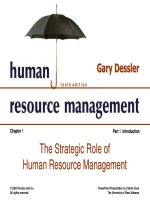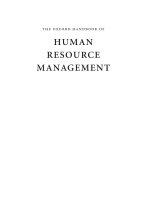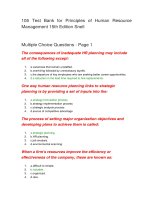Human resource management for event managing the event workforce
Bạn đang xem bản rút gọn của tài liệu. Xem và tải ngay bản đầy đủ của tài liệu tại đây (5.69 MB, 272 trang )
Human Resource Management for Events
Books in the series
Event Feasibility
William O’Toole
Events Design and Experience
Graham Berridge
Events Management (second edition)
Glenn A. J. Bowdin, Johnny Allen, William O’Toole, Rob Harris and Ian McDonnell
Innovative Marketing Communications: Strategies for the Events Industry
Guy Masterman and Emma Wood
Management of Event Operations
Julia Tum, Philippa Norton and J. Nevan Wright
Marketing Destinations and Venues for Conferences, Conventions and Business Events
Rob Davidson and Tony Rogers
Human Resource Management for Events
Lynn Van der Wagen
Human Resource Management
for Events
Managing the event workforce
Lynn Van der Wagen
AMSTERDAM
PARIS
•
• BOSTON • HEIDELBERG • LONDON • NEW YORK • OXFORD
• TOKYO
SAN DIEGO • SAN FRANCISCO • SINGAPORE • SYDNEY
Butterworth-Heinemann is an imprint of Elsevier
Butterworth-Heinemann is an imprint of Elsevier
Linacre House, Jordan Hill, Oxford OX2 8DP, UK
30 Corporate Drive, Suite 400, Burlington, MA 01803, USA
First edition 2007
Copyright © 2007, Merilynn Van der Wagen. Published by Elsevier Ltd. All rights reserved
The right of Merilynn Van der Wagen to be identified as the author of this work has been asserted
in accordance with the Copyright, Designs and Patents Act 1988
No part of this publication may be reproduced, stored in a retrieval system or transmitted
in any form or by any means electronic, mechanical, photocopying, recording or otherwise
without the prior written permission of the publisher
Permissions may be sought directly from Elsevier’s Science & Technology Rights
Department in Oxford, UK: phone (+44) (0) 1865 843830; fax (+44) (0) 1865 853333;
email: Alternatively you can submit your request online by
visiting the Elsevier web site at and selecting
Obtaining permission to use Elsevier material
Notice
No responsibility is assumed by the publisher for any injury and/or damage to persons
or property as a matter of products liability, negligence or otherwise, or from any use or
operation of any methods, products, instructions or ideas contained in the material herein.
Because of rapid advances in the medical sciences, in particular, independent verification of
diagnoses and drug dosages should be made
British Library Cataloguing in Publication Data
A catalogue record for this book is available from the British Library
Library of Congress Cataloging-in-Publication Data
A catalog record for this book is available from the Library of Congress
ISBN–13: 978-0-7506-6698-6
ISBN–10: 0-7506-6698-5
For information on all Butterworth-Heinemann publications
visit our web site at
Cover image by Craig Golding, Fairfaxphotos.com. Reproduced with permission
Typeset by Charon Tec Ltd, Chennai, India
www.charontec.com
Printed and bound in Great Britain
06
07
08
09
10
10
9
8
7
6
5
4
3
2
1
Contents
Series editors
Series preface
Preface
Acknowledgements
List of case studies
Part One: Human Resource Strategic Planning: Establishing the Context
1
2
3
4
5
6
7
The Event Environment
Human Resource Planning
Event Project Planning
Managing Volunteers
Contractor Management
Employment Law and Duty of Care
Job Analysis
vii
ix
xi
xiii
xv
1
3
19
37
56
75
89
104
Part Two: Human Resource Operations: Building the Team
121
8
9
10
11
12
13
14
15
123
141
155
172
189
203
214
228
Recruitment and Selection
Workforce Training
Job-Specific Training
Workforce Policies and Procedures
Event Organizational Culture
Organizational Communication
Leadership
Motivation and Retention
Suggested Reading
Glossary
Appendix: Assessment Project
Index
241
246
250
253
This page intentionally left blank
Series editors
Glenn A. J. Bowdin is Principal Lecturer in Events Planning at the UK Centre for Events
Management, Leeds Metropolitan University where he has responsibility for managing eventsrelated research. He is co-author of Events Management. His research interests include the area of
service quality management, specifically focusing on the area of quality costing and issues relating
to the planning, management and evaluation of events. He is a member of the Editorial Boards for
Event Management (an international journal) and Journal of Convention & Event Tourism, Chair of
AEME (Association for Events Management Education), Charter Member of the International
EMBOK (Event Management Body of Knowledge) Executive and a member of Meeting
Professionals International (MPI).
Don Getz is a Professor in the Tourism and Hospitality Management Program, Haskayne School
of Business, University of Calgary. His ongoing research involves event-related issues (e.g. management, event tourism, events and culture) and special-interest tourism (e.g. wine). Recent books
include Event Management and Event Tourism and Explore Wine Tourism: Management, Development,
Destinations. He co-founded and is a member of the Editorial Board for Event Management (an international journal).
Professor Conrad Lashley is Professor in Leisure Retailing and Director of the Centre for Leisure
Retailing at Nottingham Business School, Nottingham Trent University. He is also series editor for
the Elsevier Butterworth-Heinemann series on Hospitality Leisure and Tourism. His research
interests have largely been concerned with service quality management, and specifically employee
empowerment in service delivery. He also has research interest and publications relating to hospitality management education. Recent books include Organization Behaviour for Leisure Services,
12 Steps to Study Success, Hospitality Retail Management and Empowerment: HR Strategies for Service
Excellence. He has co-edited Franchising Hospitality Services and In Search of Hospitality: Theoretical
Perspectives and Debates. He is the past Chair of the Council for Hospitality Management Education.
He is a Chair of the British Institute of Innkeeping’s panel judges for the NITA Training awards,
and is advisor to England’s East Midlands Tourism network.
This page intentionally left blank
Series preface
The events industry, including festivals, meetings, conferences, exhibitions, incentives, sports and
a range of other events, is rapidly developing and makes a significant contribution to business and
leisure related tourism. With increased regulation and the growth of government and corporate
involvement in events, the environment has become much more complex. Event managers are
now required to identify and service a wide range of stakeholders and to balance their needs and
objectives. Though mainly operating at national levels, there has been significant growth of academic provision to meet the needs of events and related industries and the organizations that comprise them. The English speaking nations, together with key Northern European countries, have
developed programmes of study leading to the award of diploma, undergraduate and postgraduate awards. These courses focus on providing education and training for future event professionals,
and cover areas such as event planning and management, marketing, finance, human resource
management and operations. Modules in events management are also included in many tourism,
leisure, recreation and hospitality qualifications in universities and colleges.
The rapid growth of such courses has meant that there is a vast gap in the available literature on
this topic for lecturers, students and professionals alike. To this end, the Elsevier ButterworthHeinemann Events Management Series has been created to meet the need for a planned and targeted set of publications in this area.
Aimed at academic and management development in events management and related studies,
the Events Management Series:
●
●
●
●
●
●
provides a portfolio of titles which match management development needs through various
stages;
prioritizes publication of texts where there are current gaps in the market, or where current provision is unsatisfactory;
develops a portfolio of both practical and stimulating texts;
provides a basis for theoretical and research underpinning for programmes of study;
is recognized as being of consistent high quality;
will quickly become the series of first choice for both authors and users.
This page intentionally left blank
Preface
When I was asked why I wanted to write this book (rather than my novel or, more importantly, my
thesis), my response was, ‘because over the next few years London will host the Olympic Games;
South Africa, World Cup Soccer; Shanghai, EXPO; and Australia has 800 000 Catholics visiting in
2008!’ These are significant events, and they need people, they need trained people, they need
motivated people, and in turn these people need visionary leadership. They need to be managed
well, and this is the human resource management role. Every event supervisor is a human resource
manager; his or her career depends on it.
People make events successful, and there are so many of them behind the scenes. There are ticket
sellers, purchasing officers, technical assistants, media monitors, cleaners, cooks, accreditation experts,
security officers, risk managers, creative designers, announcers, singers and sweepers. Mostly
their skills are brought together for a very short time. There is no more challenging environment
for human resource management than the event business.
Events celebrate our best moments: winning the World Cup, coming first in an Olympic 100
metre swim, Black Eyed Peas performing, receiving an award, holding a 21st birthday party, or a
90th for that matter. Small or large, events commemorate our most important moments, and they
are significant in our lives and in our cultures. Because there is so much planning and organizing
to be done – because the risks are high – event professionals are needed.
There are many books on event planning, on crowd management and on economic impact
analysis. But to date, there has not been a book on human resource management for events. The
challenge for me was irresistible. I had a background in human resource management as training
manager and director of human resources in a five star hotel. This was early in my career, and
I thought the hospitality industry was the most exciting there was. This was until I worked for the
Sydney 2000 Olympic Games and discovered the world of events. It was not a soft entry into the
business; it was conflict ridden and stressful. But, hey, it was exciting. And as every event manager
will agree, all the angst is worth it when the event is a success. So with the rosy afterglow of a flawless mega event, I continued to teach in this area and became increasingly enchanted with the
event business.
This book is for anyone managing people at a festival, carnival, exhibition, show, competition,
race, display, match, concert or convention. The work needs to be analysed and allocated, contracts
prepared and signed, people hired, procedures developed, staff trained, uniformed and fed. Things
change constantly; the structure (physical and organizational) is often not in place until days or
hours before the event starts. In this controlled chaos, decisions are quick, clear communication is
essential and people need to be upbeat all the time. I have to confess that when working as a volunteer for the Sydney 2000 Olympic Games I became so tired of smiling, nodding and answering
questions on my journey to and from work (two hours each way) that in the final days I went in
mufti, carrying my volunteer uniform in my bag and saving my emotional energy for my shift. My
hope is that the bonhomie of your events is such, too, that it wears you out! That’s the measure of
success: everyone around you is uplifted and energized, and you know that this event will be fixed
in everyone’s memory for a lifetime. During the 2000 Olympic Games it was said ad nauseam,
‘This is a once in a lifetime opportunity’. If you are entering this profession, I hope that you have
many such positive opportunities.
This page intentionally left blank
Acknowledgements
The help of many people and organizations has been essential in the preparation of this book. The
author thanks the following organizations for their contributions: Alcatel Ottawa Children’s
Festival; California Traditional Music Society (CTMS) Annual Summer Solstice Folk Music, Dance
and Storytelling Festival; Beijing 2008 Olympic Games; Boat Magazine; Canmore Folk Music
Festival; Chelsea Flower Show; Edinburgh International Book Festival; Edinburgh International
Festival; European Youth and Sport Forum; FIFA World Cup Soccer 2006; Food Safety, Victoria;
Good Vibrations Festival; International Festival and Events Association (IFEA); Korean Film
Festival; Manchester 2002 Commonwealth Games; Melbourne 2006 Commonwealth Games;
National Folk Festival, Canberra; Nonprofit Risk Management Center; North Devon Journal;
Ottawa Folk Festival; Project Management Institute; Special Olympics; Studio Festi; TAFE NSW;
Trade Union Congress (TUC); Vancouver International Writers and Readers Festival; Volunteering
England; Wave Aid; Westchester County Business Journal.
The organizations listed above gave permission for me to use their material. Every effort has
been made to trace the owners of copyright material, in some cases with limited success, and I offer
apologies to any copyright holders whose rights I may have unwittingly infringed.
I would also like to thank Ruth Blackwell, Glenn Bowdin, Matthew Lazarus-Hall, Roy Masters,
Tony Webb, and the team who produced the book: Kathryn Lamberton, Francesca Ford, Lesley
Nash and Melissa Read.
This page intentionally left blank
List of case studies
1.1
1.2
2.1
2.2
2.3
3.1
3.2
4.1
4.2
4.3
5.1
6.1
6.2
6.3
7.1
8.1
8.2
8.3
9.1
9.2
10.1
10.2
10.3
11.1
11.2
12.1
12.2
12.3
13.1
13.2
14.1
14.2
15.1
15.2
IFEA human resource management standard
Alcatel Ottawa International Children’s Festival
Growth in workforce – Manchester 2002 Commonwealth Games
Sizeable market in special events insurance
Visionary leadership for Edinburgh International Festival
Tour de France Grand Depart
Studio Festi
Volunteers: a film festival’s hidden strength
Volunteers 2006TM: Play a vital role at the football event in Germany!
National Folk Festival – volunteer co-ordinator position
Game plan has silver lining for Aussies
Workers’ compensation
First insurance policies for Beijing 2008 Olympic Games volunteers underwritten
Rings of confidence
Writing job descriptions
Referral as a source of applicants
Interview for success and to avoid legal pitfalls
Edinburgh International Book Festival 2006
European Sport and Youth Forum
Training for 600 roles
California Traditional Music Society Festival
What worked? What didn’t work?
Training for an exhibition project
Ottawa Folk Festival Volunteer Code of Ethics
Conditions for volunteers for Melbourne 2006 Commonwealth Games
National Minimum Wage and Expenses UK
Planning guidelines for events in London’s Royal Parks
Shanghai World Expo 2010
Sydney-to-Hobart disaster: Who’s to blame?
Different perceptions of crowd control
Edinburgh Festival 2005 – an example of leadership style
Sydney 2000 Olympic Games – another example of leadership style
Annual Summer Solstice Folk Music, Dance and Storytelling Festival
Staging a Shakespeare Festival
14
16
28
31
34
51
52
57
66
70
86
96
99
101
115
127
135
137
143
153
164
166
169
174
185
196
198
200
205
210
216
225
235
237
This page intentionally left blank
Part One
Human resource
strategic planning:
establishing the
context
Part One of this book establishes a context for human resource management (HRM)
in the events business. The different types of events include business events (conferences and exhibitions), sports, arts, entertainment and community events, street
parades and festivals. These events may be commercial or not for profit. They may
be fundraising events or simply big parties. Most events are project based, occurring
once only or annually.
The functions of human resource management – recruitment, selection, induction,
training, and performance management – are important parts of every event organizer’s job. In the case of large events, including mega events such as the Winter
Olympics or World Cup Soccer, the size of the event clearly warrants a specialist
human resources team. For smaller events, these functions are undertaken by the
organizer, organizing committee or area managers. In this environment, there is typically a diverse range of employment arrangements and very frequently there are
volunteers involved.
The overall focus of Part One is on the development of a strategic plan for human
resource management of one or more events.
Chapter 1 discusses the unique features of the event environment that differentiate it
from other traditional business environments in which human resource management is
practised. Chapter 2 considers planning from a macro perspective, looking at the whole
workforce, which may include paid staff, volunteers and contractors who provide event
services such as catering. The growth of the event team over time and the phases of
organizational development are covered in Chapter 3, followed by a discussion in
Chapter 4 of the issues associated with volunteer management. Chapter 5 deals with the
employment of event service providers of security, cleaning, waste management and
technical support (lighting and sound). Having developed an awareness of the overall
responsibility that the event organizer has for the health and safety of everyone working
on site, employment legislation will be discussed in more detail in Chapter 6. Finally,
Chapter 7 looks at the process of job analysis, leading to the development of job descriptions, which form the basis for many other human resource functions (such as training). These are covered in Part Two when the text moves on to operational planning.
This page intentionally left blank
Chapter 1
The event environment
Learning objectives
After reading through this chapter you will be able to:
■ Differentiate between events in terms of size, scope and type of event
■ Identify a range of factors that differentiate events from more traditional ongoing
business enterprises
■ Discuss the management of events in terms of the creative and organizational
attributes of organizers
■ Describe contemporary strategic approaches to human resource management
■ Differentiate between the different groups of people comprising the event workforce
■ Discuss the emergence of event management as a profession.
Introduction
International sporting events such as the Olympic Games, World Cup Soccer, IAAF
World Championships, America’s Cup and the Commonwealth Games continue to
grow in size and investment. Most importantly, this growth is matched by the
almost exponential growth of the television audience that watches these world-class
competitions, so much so, that the organizers of opening and closing ceremonies
freely admit that these ceremonies are no longer designed for the audience seated in
the stadium, even if these spectators have paid thousands of dollars for their tickets.
In terms of viewer audience, 3900 million people (unduplicated) had access to the
coverage of the Athens 2004 Olympic Games, compared with 3600 million for Sydney
2000. In total, 35 000 hours were dedicated to the Athens 2004 Olympic Games coverage, compared with 20 000 hours for Barcelona 1992, 25 000 for Atlanta 1996 and 29 600
for Sydney 2000, representing an increase of 27 per cent (Rogge, 2004).
The ceremonies are designed with every camera shot in mind, and CAD designs
are used to visualize the on-screen effects from the various camera positions well in
advance, most particularly those from high vantage points above the stadium. Major
sponsors want to know beforehand how their logos will appear in the footage of the
ceremony – how they will be positioned and how long they will appear on screen.
There are also all sorts of political pressures brought to bear on the design of each
ceremony’s programme, with the host country branding itself according to the images
4 Human Resource Management for Events
Snow and rain are part of any contingency planning – the stage build for the
2006 Winter Olympic Games torch relay where working conditions were less than
perfect
portrayed. There are athletes, performers, players, entertainers, ushers, security
staff, police and a multitude of other staff, including volunteers, working behind the
scenes. Managing the interests of everyone involved, meeting deadlines on a multitude of projects that are interdependent and immutable are just a few of the challenges of this environment.
The 2005 Live 8 Concerts held in ten cities, including London, Philadelphia, Paris,
Berlin, Johannesburg, Rome and Moscow, played to hundreds of thousands of
people. A TV audience of several hundred million watched these gigs. In this case,
the event was not a sporting event but a social justice initiative to eliminate poverty
in Africa. This example further illustrates the challenges of producing an event on
such a large scale, with specific political and economic aims in mind. The workforce
for these events is similar in scale to sporting events such as the 2008 Olympic
Games to be held in Beijing, recruiting 70 000 volunteers for the Summer Games and
30 000 for the Paralympic Games. Added to this there is the paid workforce of the
organizing committee.
For most events the additional size and scope of the contractor workforce are often
underestimated. Many services, such as catering and cleaning, are contracted out and
there is sometimes debate about whose responsibility it is to develop the event-related
knowledge and customer service skills required by contractor employees on the site.
As Goldblatt (2005b, p. 118) points out, ‘You are being paid for creating memorable
positive experiences, and you and your staff are the critical resource that makes the
guest’s experience memorable. Issues such as your human resource organization,
training, and employee retention are vital if you are to remain competitive.’
The event environment 5
Events: a new context for
HR management
Events are not only challenging for management in their size, scope and timeline.
Human resource management remains a key success factor in smaller, locally based
events involving only a limited number of people, as the range of stakeholders and
participants need to be brought to one purpose. Frequently, even the organizing committee cannot agree on the primary purpose of the event! Anyone who has sat on an
event committee would know this.
Essentially, the main differences between the management of an event and the
management of an ongoing business enterprise is that the event is generally intangible and untested, and there is only one chance to get it right. In contrast, a retail
store that doesn’t sell stock in the current month can put it all on sale the following
month and hope to at least recover its costs.
Events are often high-stakes ventures. At the mid-scale level, a festival can represent
the labour and dreams of the whole community, while at the lower end, in terms of
scale, the most obvious example is a wedding which, although small, may represent
a family’s life savings, thus making it a high-stakes venture which needs to run flawlessly. (One hopes it is a once in a lifetime celebration!)
Classification of events
There have been many efforts to classify events by type. The main classifications are
generally business, sporting and cultural (see Table 1.1). While technically sports
would come under the umbrella of culture, it is useful to differentiate this category.
One way in which events can be further classified is as not-for-profit and commercial
(profitable) events.
Characteristics differentiating
events
Many event characteristics have already been discussed and these will be elaborated
further. First, however, it is important to attempt to define ‘event’ and ‘event product’. As Brown and James (2004) point out, there are as many definitions as there are
text books. For Goldblatt (1997, p. 2) a special event is a ‘unique moment in time celebrated with ceremony and ritual to satisfy specific needs’. While this definition
clearly satisfies most events falling in the category of cultural events, it is not entirely
satisfactory for many large-scale, commercial or corporate events such as product
launches and other business events which are not necessarily celebratory. Perhaps
a definition on which most writers would agree is that an event is generally a complex
social endeavour characterized by sophisticated planning with a fixed deadline,
often involving numerous stakeholders.
6 Human Resource Management for Events
Table 1.1
Classification of events
Business
Meetings and conferences
Many associations have annual conferences
around the world and the bid process for
these is conducted many years in advance.
For example, the 9th International
Conference on Alzheimer’s Disease and
Related Disorders, presented by the
Alzheimer’s Association (USA), was the
largest gathering of Alzheimer researchers
in history. More than 4500 scientists from
around the world attended. However, in
terms of conventions, this is only mid-scale.
Exhibitions
The world’s biggest information and
communication technology exhibition,
CeBIT, is held annually. In 2004, a total of
6411 firms from 64 countries presented
their products and systems at the Hanover
show which attracted about 500 000
visitors.
Many agricultural fairs have animal exhibitions
and competitions, adding somewhat to the
challenges for organizers. Bulls, horses and
dogs all require careful handling!
Sports
Cultural
Incentives
Incentives are corporate events organized
for high-achieving staff, often held at a
resort or holiday destination, but including
work-related meetings and presentations.
Competitive sports events
All grades of sporting competition from
amateur to professional fall into this
category, which also covers a multitude of
sports ranging from baseball, cricket and
football to netball and gymnastics.
Non-competitive
sports events
Fun and non-competitive activities
characterize this type of sporting event,
which includes runs and walks supporting
charities and dragon boat races of the
non-competitive variety.
Arts
Arts festivals come in a multitude of formats,
from the Adelaide Festival of Ideas to the
Edinburgh Festival of classical music, opera,
theatre and dance.
Entertainment
There are many music concerts held around
the world, on both a large and small scale,
and featuring many different music genres.
Television and the Internet
Many events are played out on television
or the World Wide Web. The search for the
‘American Idol’ is an example of one such
contemporary trend. In China, the equivalent
is the competition for ‘Super Voice Girl’.
The event environment 7
Table 1.1
(Continued)
Community – historical and
anniversary celebrations
Founding days, centenaries, bicentenaries
and other anniversary days are often
celebrated. Multicultural festivals also fall
into this category.
Social action – cause-related
events
Generally fundraising in nature, this type
of event includes concerts such as Live 8
and relief concerts to raise money for the
victims of the 2004 tsunami in South East
Asia and Southern Asia and the 2005
hurricanes in the USA.
Protests
Many street protests – against globalization,
for example – fall into this category. There
is an annual calendar of protest events and
international days of action around
the world.
Life cycle/milestones
Baptisms, Bar Mitzvahs, weddings and
funerals are all examples of life-cycle
events. While most are small scale, 600 000
people lined the streets to watch the
wedding of Charles and Diana, and one
million people lined the route of Diana’s
funeral procession.
Religious
Ranging from small to large scale and
represented, for example, by the Kumbha
Mela in India, which attracted 70 million
people over 44 days in 2001.
The event product is the whole package of goods and services. This is primarily
the event programme but it also includes merchandise, food, service, the environment, transport, queues etc. Salem et al. (2004, p. 19) describe the event product as ‘a
unique blend of activities, which are the tools for achieving the overall event aims
and satisfying customer needs’. In order to achieve its purpose, an event must meet
human needs at all levels, and the management of human resources, in order to provide an optimal experience for the audience, is a critical part of product planning.
The things that make marketing of event products complex are their features
of intangibility, inseparability, heterogeneity and perishability (Drummond and
Anderson, 2004). In particular, the product leaves little that lasts, other than a few
photos and other memorabilia. One aspect of the event product that is seldom
acknowledged in discussing event marketing is its anticipatory element. Most events
are something that the audience and, indeed, the participants look forward to since
they are generally significant and positive social occasions. By enhancing this part
of the product one can enhance service and satisfaction. Staff training usually has
the event programme and related service delivery as its focus. This needs to
be expanded to cover the lead-up period during which staff will be selling tickets,
registering participants and providing information. Often the client works with the
event management company over a long period. The service provided during this
sometimes stressful time needs to be managed just as well as the actual event
production.
8 Human Resource Management for Events
Key characteristics of the event industry at the present time include the following:
1 Worldwide interest. Increasing globalization, a growing television audience and
exposure to the World Wide Web have led to increased interest in events as a reflection of contemporary culture. In some extreme instances, sporting events can stop
the nation and the world. This is certainly the case with some athletic events in the
Summer Olympics. Two billion viewers watched Pope John Paul II’s funeral. The
execution of this event was doubtlessly planned in infinite detail – an extraordinary ceremony attended by the world’s leaders and watched worldwide.
2 Competitive environment. Countries and cities involved in bid processes demonstrate the competitive nature of event procurement. Many conferences and exhibitions attract thousands of visitors and their expenditure is generally much higher
than the average international visitor. All over the world – in China, in particular –
there are initiatives to build bigger and better convention facilities in order to
attract this lucrative segment.
3 Economic and tourism impact. Business, cultural and sporting events also contribute significantly to the economic and tourism impact on cities and even countries. Many cities and suburbs are branded by their hallmark events, including
Edinburgh, Monaco, Rio, Calgary and Chelsea. Taken into account here is the
direct expenditure of visitors and event organizers as well as the indirect (or flow
on) economic effect on the wider community.
4 Authentic or imaginative event products. Consumers look for a point of difference
and, in particular, authenticity when visiting an event as a tourist. Where leisure
options are a dime a dozen, an event needs to provide the motivation to attend.
In the case of annual events, the visitor needs a reason to return. WOMAD is an
example of a popular and enduring event, held in several cities. WOMAD stands
for World of Music, Arts and Dance, expressing the central aim of the WOMAD
festival, which is to bring together and to celebrate many forms of music, arts
and dance drawn from countries and cultures all over the world. The organizers
say they aim to excite, to inform, and to create awareness of the worth and potential of a multicultural society.
5 Benefits to the host community. The community expects to be consulted when there
is an anticipated impact on their local area. The community needs to know that
the positive impacts will outweigh the short-term negative effects. There are
many residents of Melbourne who remain opposed to the motor racing held
annually in their city. On the other hand, Chinese citizens displaced by the
massive construction projects of the 2008 Olympic Games demonstrated
resigned acceptance to the planning priorities established by their government.
Even the smallest community event must be approved by the local council,
whose role it is to ensure that the event is a good fit with the community, has
minimal risk and, indeed, will contribute in a positive way to the social fabric of
the region.
6 Minimizing risk. Public liability and other insurances are significant considerations for event organizers. Safety is a primary concern, particularly as there are
additional risks associated with mass gatherings. Crowd behaviour and potential fatalities at sporting and music events are worldwide issues.
7 Political influence. Where many large events require government support at one
level or another (including local council level) there are always political considerations. In Australia, for example, a regional event is much more likely to attract
funding than a city event since regional development is a political priority.









